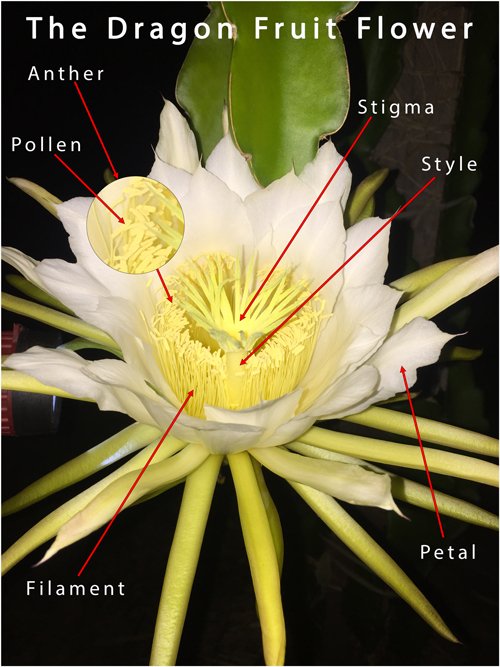
Guide to Dragon Fruit
Common Terms:
In this growers Guide to Dragon Fruit, we explore the colourful world of the Dragon Fruit lexicon, this wonderful journey that is full of language you’ve seldom heard before and sometimes down right confusing. In this Guide to Dragon Fruit, we haver listed some basic, common terms that are often used when discussong dragon fruit and their never ending changes.
Self-Fertile: Self-Fertile means that a plant can pollinate itself with its own pollen so that it does not require pollen from another flower or plant.
Self-Sterile: Self-Sterile means that a plant must receive pollen from another plant of the same species (not variety) in order to be pollinated.
Cross Pollination: Cross-pollination occurs when pollen is delivered from the stamen of one flower to the stigma of a flower on another plant of the same species.
Brix: Degrees Brix (symbol °Bx) is a measure commonly used to measure dissolved sugar content of an aqueous solution. One degree Brix is 1 gram of sucrose in 100 grams of solution and represents the strength of the solution aspercentage of mass.
Old Growth: Old growth, also known as Mature Growth, are limbs of the plant that have been longer growing, They are usually darker in colour, harder in body and rougher in texture. They are often defined by a thin pale line that thickens with age along the outer edges of the limb. Typically, these limbs are older than 2 years old. Mature growth are more resilant to deseases and produce a better plant that bears fruit sooner.
New Growth: New growth are usually softer and lighter in colour. They are usually unblemished with no defined line along the limb edge. These take longer to establish and bear fruit.
Aerial Roots: Dragon Fruit often grow
Dragon Fruit often grow  aerial roots, usually from their limbs. They are both terrestrial (growing from the ground) and epiphytic (growing on other plants). Dragon Fruit love to climb, and use their aerial roots to cling to structures and other plants as they grow.
aerial roots, usually from their limbs. They are both terrestrial (growing from the ground) and epiphytic (growing on other plants). Dragon Fruit love to climb, and use their aerial roots to cling to structures and other plants as they grow.
Day-Long: This means requiring a long photoperiod in order to flower, usually at least 10 hours of daylight.

Anatomy:
Dragon Fruit flowers are made up of different parts or components. As a whole, they look stunning, but knowing the different parts can mean understanding pollination and producing beautiful, delicious fruit as well.
Stigma: The stigma, together with the style and ovary (typically called the stigma-style-ovary system) comprises the pistil, which is part of the female reproductive organ of a plant. The stigma receives pollen and it is on the stigma that the pollen grain germinates. Often sticky, the stigma is adapted in various ways to catch and trap pollen with various hairs, flaps, or sculpturings. The pollen may be captured from the air (wind-borne pollen), from visiting insects or other animals.
Anther: Anthers are part of the male reproductive system in flowers, and together with the Filament, make up the Stamen. It is here that pollen is produced.
Pollen: Pollen is a powdery substance produced by seed plants. It consists of pollen grains, which produce male gametes (sperm cells).
Filament: The Filament is part of the stamen and is the thin stalk that connects the anthers to the flower.
Style: The style is a narrow, upward extension of the ovary, connecting it to the stigmatic papillae (base of the Stigma). It is through this tube that the germinated pollen travels to the ovary to fertilise the Dragon Fruit seeds.
Ovary: The ovary is a part of the female reproductive organ of the flower. Specifically, it is the part of the pistil which holds the ovules. The mature, ripened ovary of the flower is called the fruit.
Petal: Petals are modifiedleaves that surround the reproductive parts of flowers. They are often brightly coloured or unusually shaped to attract pollinators.
Fruit Development:
Dragon Fruit flowers and fruit develop over about 8 weeks, 3 weeks for the flower to bloom and 5 weeks for the dragon fruit to ripen. In this growers Guide to Dragon Fruit are a series of photos showing the development of the bud into a delicious sweet fruit.












